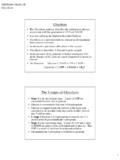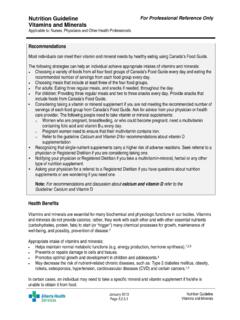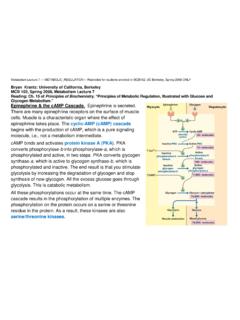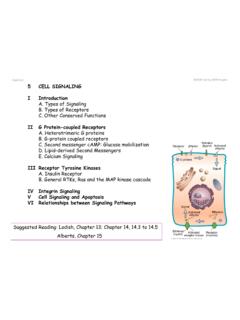Transcription of Mathematical Modelling in Systems Biology: An Introduction
1 Mathematical Modelling in Systems Biology: An IntroductionBrian IngallsApplied MathematicsUniversity of 18, 20122 PrefaceSystems techniques are integral to current research in molecular cell biology. These Systems ap-proaches stand in contrast to the historically reductionist paradigm of molecular biology. The shifttoward a Systems perspective was gradual; it passed a turning point at the end of the 20thcen-tury, when newly developed experimental techniques provided system-level observations of cellularnetworks. These observations revealed the full complexityof these networks, and made it clearthat traditional (largely qualitative) molecular biologytechniques are ill-equipped for the investi-gation of these Systems , which often exhibit non-intuitivebehaviour.
2 This point was illustrated in athought experiment proposed by Yuri Lazebnik (Lazebnik, 2002). He described a (failed) attemptto reverse-engineer a transistor radio using qualitative methods analogous to those used in tradi-tional molecular biology. Lazebnik s exercise demonstrates that without a quantitative frameworkto describe large networks of interacting components, the functioning of cellular networks cannotbe resolved. A quantitative approach to molecular biology allows traditional interaction diagramsto be extended to mechanistic Mathematical models. These models serve as working hypotheses:they help us to understand and predict the behaviour of complex application of Mathematical Modelling to molecular cell biology is not a new endeavour;there is a long history of Mathematical descriptions of biochemical and genetic networks.
3 Successfulapplications include Alan Turing s description of patterning in development (discussed by Murray,2003), the models of neuronal signalling developed by Alan Hodgkin and Andrew Huxley (reviewedby Rinzel, 1990), and Denis Noble s mechanistic Modelling of the heart (Noble, 2004). Despite thesesuccesses, this sort of Mathematical work has not been considered central to (most of) molecularcell biology. That attitude is changing; system-level investigations are now frequently accompaniedby Mathematical models, and such models may soon become requisites for describing the behaviourof cellular this book aims to achieveMathematical Modelling is becoming an increasingly valuable tool for molecular cell biology.
4 Con-sequently, it is important for life scientists to have a background in the relevant Mathematical tech-niques, so that they can participate in the construction, analysis, and critique of published the other hand, those with Mathematical training mathematicians, engineers and physicists now have increased opportunity to participate in molecularcell biology research. This book aimsto provide both of these groups readers with backgrounds incell biology or mathematics withan Introduction to the key concepts that are needed for the construction and investigation of math-ematical models in molecular Systems hope that, after studying this book, the reader will be prepared to engage with publishedmodels of cellular networks.
5 By engage , I mean not only to understand these models, but also toianalyse them critically (both their construction and theirinterpretation). Readers should also bein a position to construct and analyse their own models, given appropriate experimental this book was written forThis book evolved from a course I teach to upper-level (junior/senior) undergraduate my experience, the material is accessible to students in any science or engineering program,provided they have some background in calculus and are comfortable with mathematics. I alsoteach this material as a half-semester graduate course to students in math and engineering.
6 Thetext could easily be adapted to a graduate course for life science students. Additionally, I hopethat interested researchers at all levels will find the book useful for Mathematical prerequisite for this text is a working knowledge of the derivative; this isusually reached after a first course in calculus, which should also bring a level of comfort withmathematical concepts and manipulations. A brief review ofsome fundamental mathematicalnotions is included as Appendix B. The models in this text arebased on differential equations, buttraditional solution techniques are not covered.
7 Models are developed directly from chemical andgenetic principles, and most of the model analysis is carried out via computational software. Toencourage interaction with the Mathematical techniques, exercises are included throughout the reader is urged to take the time to complete these exercises as they appear; they will confirmthat the concepts and techniques have been properly understood. (All of the in-text exercisescan be completed with pen-and-paper calculations; none areespecially time-consuming. Completesolutions to these exercises are posted at the book s website.)
8 More involved problems mostlyinvolving computational software are included in the end-of-chapter problem Introduction to computational software is included as Appendix C. Two packages aredescribed: XPPAUT, a freely available program that that waswritten specifically for dynamicmodelling; and MATLAB, which is a more comprehensive computational tool. Readers with nobackground in computation will find XPPAUT more have found that most students can grasp the necessary cell and molecular biology withouta prior university-level course. The required background is briefly reviewed in Appendix A; morespecialized topics are introduced throughout the text.
9 Thestarting point for this material is a basicknowledge of (high-school) chemistry, which is needed for adiscussion of molecular phenomena,such as chemical this book is organizedThe first four chapters cover the basics of Mathematical Modelling in molecular Systems should be read sequentially. The last four chapters address specific biological domains. Thematerial in these chapters is not cumulative; they can be studied in any order. After Chapter 2,each chapter ends with an optional section, marked with an asterisk (*). These optional sectionsaddress specialized Modelling topics, some of which demandadditional Mathematical background(reviewed in Appendix B).
10 Chapter 1 introduces molecular Systems biology and describes some basic notions of mathemati-cal Modelling , concluding with four short case-studies. Chapter 2 introduces dynamic mathematicalmodels of chemical reaction networks. These are differential equation models based on mass-action bingalls/MathModellingSysBioiirate laws. Some basic methods for analysis and simulation are described. Chapter 3 covers bio-chemical kinetics, providing rate laws for biochemical processes ( enzyme-catalysed reactionsand cooperative binding). An optional section treats common approximation methods.









